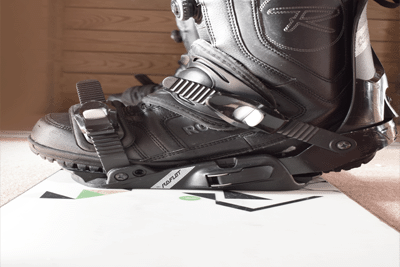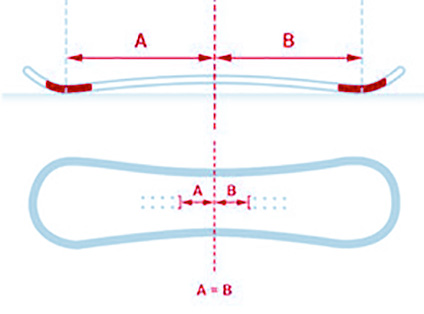Choice of Snow
HOW TO CHOOSE THE RIGHT SNOWBOARD
Easy-gliss will help you select the snowboard that suits you. Determine:
- The ideal Snowboard size
- Your capacity level
- Board width
- Your preferred riding style/programme
 CAPACITY LEVEL
CAPACITY LEVEL
The higher your level, the bigger your snowboard should be (1 to 2 cm more per level). The size indicated is suitable for beginners/intermediate level.
There are boards designed for each skill level, each addressing the specific needs of the snowboarder. Flexibility, shape, length, construction, materials, design and intended use are equally important when designing a snowboard for a specific skill level.
BEGINNER/INTERMEDIATE
A snowboarder who is new to snowboarding or who is working on his or her technique falls under this level.
Choose a snowboard:
- Flexible and soft
- Snowboard size indicated
INTERMEDIATE/ADVANCED
The majority of riders and snowboards fall into this level.
You will ride on gentle to medium slopes (green to red runs). Your speed is low or medium and you start riding at the edge of the track:
- Snowboard size indicated or 2 to 4 cm more
ADVANCED/EXPERT
More aggressive and skilled rider.
You make precise turns on medium to steep slopes (blue to black runs). You are able to do off-piste, small jumps, sliding turns and you're starting to ride switch.
Expert: Precise and effective trajectories on all types of terrain at a sustained speed. You have many years of experience:
- Snowboard size indicated or 4 to 6 cm more
WIDTH
When the width of the board is correctly sized, the boots are close to the edges of the snowboard, but not too close either, so as not to touch the snow in the turns (see pictures below). Extending your toes and heels slightly over the edges of the snowboard allows you to apply leverage and modulate the pressure with your ankles. If your boots extend too far over the edge, they rub the snow during turns and cause you to fall. To determine the ideal snowboard width, see the table below.

Men's size (US) |
- |
5.0 - 7.5 |
7.0 - 9.5 |
8.5 - 10.5 |
9.5 - 11.5 |
10.5 and over |
Women's size (US) |
Up to 6.0 |
6.0 - 8.5 |
8.0 - 10.5 |
10 and over |
- |
- |
Men's size (FR) |
- |
37 - 39.5 |
39 - 42.5 |
41 - 44 |
42.5 - 45 |
44 and over |
Women's size (FR) |
35 - 37 |
37 - 40 |
39.5 - 43 |
42.5 and over |
- |
- |
Snowboard width (mm) |
225-235 |
236-245 |
246-250 |
251-254 |
255-259 |
260+ |
Snowboard width |
narrow / women |
Ordinary |
large / Wide |
|||
Snowboarding sizes vary by manufacturer, and even by model, and some boots are made especially with a low profile. Low profile boots allow a rider to use a narrower snowboard.
If you're a freerider and put a lot of angles when setting on your bindings, you can go with a slightly narrower board. However, if you ride freestyle with 0°/0° angles, pay attention to the maximum size your future board will offer you.
 PROGRAMME OF CHOICE
PROGRAMME OF CHOICE
The programme is the style of skiing and terrain you prefer.
All mountain, freestyle, freeride, back country, park, splitboard.
Determine what you want to ride and how to fit your snowboard.
ALL-MOUNTAIN
All-mountain snowboards are multi-purpose. They are at ease in powder, park, piste, etc. The vast majority of snowboarders choose these snowboards for their great versatility. If you are just starting out or don't know exactly what you need, an all-mountain snowboard is an excellent choice.
Choose a snowboard that is 15 to 20 cm shorter than your body size.
FREESTYLE
Freestyle or park boards tend to be a little shorter and are great for parks, rails, beams, etc. Freestyle boards often have a true twin shape, and are usually selected by those looking to have fun and ride the parks. A more multi-purpose version that combines all-mountain versatility with off-road enjoyment.
Choose a snowboard that is 20 to 25 cm shorter than your body size.
FREERIDE
Freeride snowboards are designed for the rider who spends most of the day on and off the slopes. They generally have a more rigorous flex and are fitted in longer sizes. These boards often have a directional shape designed to glide optimally in one direction.
BACKOUNTRY
Ideal for powder snow, often associated with freeride boards, they sometimes have a wider skid and a narrow heel. Fixture inserts are often set back on this type of snowboard to help the rider float. They often have a generous rocker and the tips are raised, which also helps to maintain flow through powder snow.
SNOW PARK
If you spend most of your time in snow parks with your head in the air, you are looking for a park-style snowboard. More exclusive than freestyle snowboards, these snowboards are light and easy to handle.
SPLITBOARD
A split snowboard designed specifically for the snowboarder looking to ride the most pristine and wild terrain. Splitboards are designed to split into two separate halves for touring and uphill travel (special bindings are required). Once you have reached the top, you put the two halves together again for the descent and slide down as normal. Don't forget the appropriate avalanche safety equipment and be aware of the terrain, weather and snow conditions when riding your splitboard.
CAPACITY
Snowboards make turns of different sizes depending on their sidecut radius, skate widths and rocker.
SIDECUT RADIUS
The radius or sidecut is the radius that your snowboard creates if the snowboard curve is extended into a full circle. A small sidecut indicates a smaller circle and therefore smaller turns.
ROCKER
The rocker is the progressive inclination of the tip, as opposed to the camber, which is the raised part.
A rocker in the tip and tail of your snowboard makes turning easier. Sometimes this is called an unattractive rocker. It also facilitates flotation in deep or powder snow.
 WOMEN'S SNOWBOARD
WOMEN'S SNOWBOARD
Women's bodies and turn mechanics are not the same as men's. Since women tend to have less body mass and smaller feet than men of the same height, women's boards are narrower with thinner profiles and softer flexes.
However, the rules for choosing your board are the same for women so you can refer to the previous tips.
 SNOWBOARD CHILDREN
SNOWBOARD CHILDREN
Your child may still be growing, so it is important to find a snowboard that will suit them for a long time, but be careful not to choose a board that is too big (a board that is too big endangers the safety of your child). The right size snowboard will help your child progress faster and have much more fun. Children's snowboards are generally more flexible, to give them the best support on their first ride.
TWIN TIP AND ROCKER, THE WINNING COMBINATION FOR JUNIOR SNOWBOARDS
The twin-tip snowboard is a safe bet for children's snowboards.
Symmetrical front and back. It makes it easier to glide forward and backward.
The rocker raises the snowboard at the heel and the tip. This will take the young snowboarder through their first turns and help avoid to avoid falls.
This type of board makes it easier to learn!

